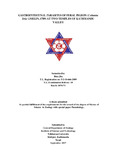Please use this identifier to cite or link to this item:
https://elibrary.tucl.edu.np/handle/123456789/1410| Title: | Gastrointestinal Parasites of Feral Pigeon (Columba Livia Gmelin, 1789) at Two Temples of Kathmandu Valley |
| Authors: | Jha, Bina |
| Keywords: | Gastrointestinal parasites;Temple pigeons;KATHMANDU VALLEY |
| Issue Date: | 2017 |
| Abstract: | Pigeons (Order Columbiformes) are found worldwide and are known to be originated from Europe, North Africa and Asia. Feral pigeons are found almost everywhere except the Sahara desert, Antarctica and high Arctic. The present study was conducted to evaluate the general prevalence, specific prevalence, compare area-wise prevalence, infection-wise prevalence and identification of gastrointestinal parasites of feral pigeons in two temples viz. Pashupatinath temple and Krishna temple of Kathmandu valley, Nepal. Total 120 fecal samples were collected by opportunistic random sampling method on 22nd and 23rd April, 2016 A.D. to determine the gastrointestinal parasites of feral temple pigeons. The qualitative examination of fecal samples was done by direct microscopic examination, flotation technique and sedimentation technique whereas Microsoft Excel 2007 and “R” version 3.3.1 software package was used for data analysis. Out of total 120 fecal samples examined, 109 fecal samples were positive with overall prevalence of 90.83%. Total of six GI parasites were identified that includes one genera of protozoa: Eimeria sp. 52 (43.34%) and five genera of helminthes: Capillaria sp. 62 (51.67%) followed by Ascaridia sp. 33 (27.50%), Heterakis sp. 23 (19.17%), Syngamus sp. five (4.17%) and Tetrameres sp. two (1.70%). The prevalence rate of helminthes 100 (83.34%) was higher than prevalence rate of protozoan parasites 52 (43.34%). Statistically, the difference in prevalence of helminthes and protozoan parasites were found to be significant (χ²=15.14, P<0.05). The infection rate in two study areas, Pashupatinath temple and Krishna temple was found 57 (95%) and 52 (86.67%) respectively. Statistically, the difference in prevalence of GI parasitic infection among study area was found to be insignificant (χ²=0.24, P>0.05). Mixed infection was more common 61 (50.84%) than single infection 48 (40%). Statistically, the differences in the prevalence of single and mixed infections were found to be insignificant (χ² =1.56, P>0.05). Among multiple infections, double infection showed the highest rate 53 (86.88%) than the multiple infection 8 (13.12%) in this study. The current study revealed heavy infection in feral pigeons at two temples of Kathmandu valley. The study indicated that feral pigeons are highly susceptible to GI parasites. Therefore, sustainable action should be designed and implemented to control the parasitic infection and reduce the health hazards of feral temple pigeons. |
| URI: | http://elibrary.tucl.edu.np/handle/123456789/1410 |
| Appears in Collections: | Zoology |
Files in This Item:
| File | Description | Size | Format | |
|---|---|---|---|---|
| GASTROINTESTINAL PARASITES OF FERAL PIGEON (Columba livia GMELIN, 1789) AT TWO TEMPLES OF KATHMAN.pdf | 1.08 MB | Adobe PDF |  View/Open |
Items in DSpace are protected by copyright, with all rights reserved, unless otherwise indicated.
